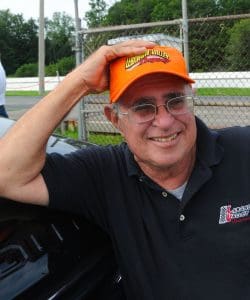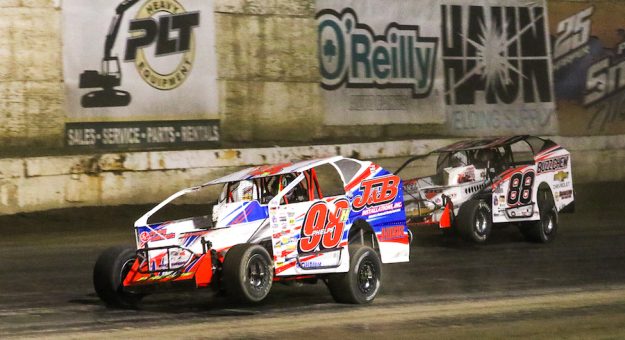After promoting, by his estimate, something like 17,000 nights of racing at multiple tracks, winning the prestigious Auto Racing Promoter of the Year honor and spending untold hours on a grader or under a headset in the control tower, Howard Commander is still optimistic about local racing.
He’s one of the most influential track operators in the country.
And when Commander says something about the future of the sport, it’s best to listen closely.
Short fields, high taxes and bored spectators: Commander’s worked hard on ways to address all three modern realities.
“Right now, I want to be on the positive side of everything,” Commander said. “If the government knew how much fun auto racing is, they would definitely put a use tax on what we’re doing, but I guess they don’t understand the fun of it.
“During the pandemic, (the government) shut New York state down and for the first time in my life, I ran nine races with no spectators in the stands and ended up losing $250,000 that year, just to keep everyone alive and well.”
Commander is best known as the decades-long promoter of Lebanon Valley Speedway in West Lebanon, N.Y., but the shadow he’s cast over short-track racing, especially in the Northeast, is long and enveloping.
Besides Lebanon Valley, Commander oversees operations at nearby Albany-Saratoga Speedway in Malta, and recently concluded a stint assisting at Airborne Park Speedway in Plattsburgh, N.Y., under then-promoter Mike Perrotte.
He’s also promoted, or helped promote, races in places as varied as New York’s historic Orange County Fair Speedway in Middletown, and at the Talladega Short Track in Alabama.
“I had an interest in Talladega because (DIRT Motorsports founder) Glenn Donnelly bet me that I couldn’t make money there,” he said. “We didn’t get rich but we did make a little money. And it was there that I got introduced to crate motors, in their limited late model class. It’s becoming so you’re going to have to use a crate motor for beginners, and what we have to do is keep the strictest of rules for crate motors, because racers will cheat if they can get away with it.
“One of the wealthier teams down there had a crate motor, and they clearanced it. If you looked at it 100 times, you couldn’t find anything wrong with it. And this guy won probably half the races they ran.”
At that time, the widespread use of Chevrolet Performance crate engines such as the 602 and 604 hadn’t yet made inroads into the modified hotbed for New York and environs. Yet for most of his career, and at most of his promotional properties, Commander is a modified man, the big-block variety.

Lebanon Valley is known, after all, as the Valley of Speed and it’s the big blocks that hammer its high banks. In recent years, Commander has experimented with a 500-cubic-inch spec big-block engine, which won at least one feature event at Lebanon Valley.
“We still feature modifieds at Lebanon and a few other tracks, but it’s become where the crate motor is going to be the way to go, at least for beginners,” he predicted.
That, to Commander, summarizes the promoter’s quandary: How to entertain spectators with continuous, compelling competition, while at the same time trying hard to keep from bankrupting your racers.
Commander believes strongly that for some tracks, in some areas, a basic program centered around an affordable lead class is essential to survival. He got some practical experience by trying to run crate sportsman cars as the lead class in Plattsburgh.
Thanks to external forces, the verdict on how well it worked remains elusive.
“Plattsburgh is a beautiful track. I wanted to try what sportsman cars could do there with crate motors,” he explained. “Could you make a buck? What I found out was that without that speed (in this case, like a big-block modified), you get a certain contingent of people who don’t want to watch it. I didn’t lose any money but I didn’t make a lot, either.
“We got rained out of eight out of 18 shows, so I really can’t say whether it worked. When the sun was shining, the crowd was acceptable, but when it wasn’t the crowds were only fair. But I wanted to try it because in the greater realm of things, you really could get back to a crate-motor deal for weekly racing.
“I really haven’t thought about it long enough to have a solution (to local racing’s long-term health). At Plattsburgh, I was trying to make it pay with 1,000 people in the stands,” Commander added. “The solution is having a lot of cars, and a lot of people having fun. If you can get 300 to 400 people that way, I think you can make it and it’s going to be a crate program that does it. If you can’t get 1,000 people consistently, you can’t make it because the insurance and everything else is so expensive today when you want to open a race track.
“The problem doesn’t originate with what class you’re running,” he continued. “It originates with the population base within a 30-to-60-mile radius of your track. Without that, you’re doomed. You can spend millions of dollars and have nothing. Now, as the economy starts to get better and better, and as land values go up and up, good dragways and good speedways have closed this past fall because the land value is worth far more than the speedway.
“If you can make $100,000 but the land value is in the millions, that’s a no-brainer. If you’re in the right population area, your land is going to become so, so valuable. And we’re going to see more and more of that.”
While he’s not yet ready to disclose his ideas, Commander says he’s working on a long-term plan to develop new revenue sources at Lebanon Valley and Albany-Saratoga in coming seasons.
All that said, Commander goes further in his hope the northeast-style big-block modified remains viable as a weekly class at tracks that can support their cost. Besides the aforementioned spec big-block engine, Commander also experimented with spec Brodix heads as a big-block cost-containment measure.
The larger issue, at least for his tracks, has been putting on a disciplined show, with minimal downtime between races, good concession prices and a track surface that promotes speed, which is what Commander believes is what the fans expect most of all. He also criticized the current trend among modified teams to relocate the Panhard bar to the left side of the car, which Commander said tends to rip up the inside groove as the night progresses.
“Every track, no matter what the speed, has these Indian-file nights where there’s no passing,” he said. “Other tracks have great nights and I think it all comes down to track preparation. We spend a lot of money on track prep. It allows us to use the products that keep the surface relatively dust-free, because in order to have high speed, you need a smooth track.
“And at Lebanon, I now have a group of modified drivers who almost never hit each other. There has to be entertainment. I have six tow trucks and one night, five of them broke down, so an accident turns into a 20-minute thing.”
Keeping local racing strong will ultimately come down to keeping competitors from going broke, which is part of the crate engine’s preferability to some track operators.
“Even with a crate motor, it’s expensive for a working guy to get his car to the track and get his pit crew in, because without the pit money, half the speedways today would be out of business,” he said. “It’s like trying to make a great pie, or a great roast, without having all the ingredients.”
It’s a concept that’s so essential, it bears repeating: Racing, regardless of the venue or the rules, is all about entertaining the people who come through the gate. Which is why Commander believes proper track prep, just for openers, is so important.
“What I found out, and what I feel, is that whichever motor you pick, and can keep it relatively legal, it ultimately isn’t about the motor,” he said. “It gets back to great drivers, and great handling. There will always be heroes in every class, but never forget: The real racers are the ones who want some speed.”
THIS ARTICLE IS REPOSTED FROM THE MARCH, 20th EDITION OF SPEED SPORT INSIDER
SPEED SPORT Insider is the ad-free premium extension of SPEEDSPORT.com. Insider is dedicated to the best and brightest in motorsports journalism – created by the best writers, photographers and reporters in the business. From veteran Hall of Fame writers like Bones Bourcier, Dave Argabright, Pat Sullivan, Keith Waltz, Ralph Sheheen and Editor in Chef Mike Kerchner, to behind the scenes SPEED SPORT reporters like Grace Woelbing, David Hoffman and more.
By subscribing to Insider, you not only get exclusive access to this premium content, but you support the journalists that are vital to telling the stories that matter most. Subscriptions are just $5/mo or $44.95 for an entire year. View plans and details.

